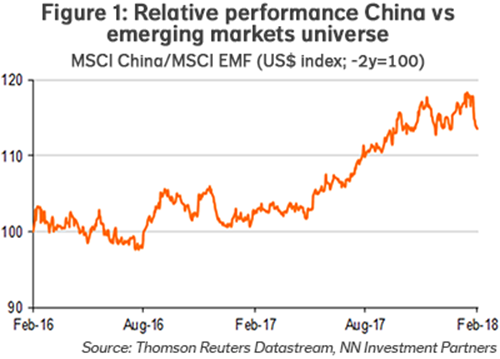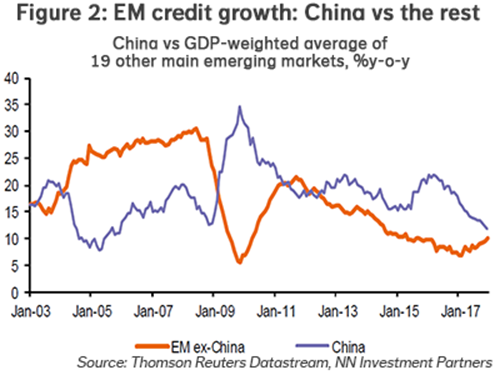
NN IP: Remarkable resilience in emerging markets
During global equity market corrections, particularly those driven by inflation worries and rising DM bond yields, emerging equity markets tend to struggle. Emerging Markets strategist M.J. Bakkum explains why this time is different.
19.02.2018 | 10:00 Uhr
During sharp global equity market corrections, particularly those driven by inflation worries and rising DM bond yields, emerging equity markets tend to struggle. General risk-off in markets typically means aggressive selling in EM, particularly in the countries where macro imbalances are the largest and foreign capital needs the highest. During the global equity market correction of the past weeks, EM has underperformed DM, but only by a modest 2 percentage points. Interestingly enough, the traditional weak links, such as Turkey, Brazil and Colombia, were not responsible for the underperformance. As a matter of fact, they have held up well and even outperformed the EM average.

The only market that has clearly underperformed in the past weeks is China (see Figure 1). We can explain this by investor positioning and the strong outperformance of China in the preceding weeks and months. The Chinese market and particularly the Chinese Internet names were the segments that had inflated the most within global emerging markets. So while the Chinese underperformance in itself should not have been a big surprise, it remains remarkable that other EMs that should be more sensitive to big movements in DM interest rates have held up so well. After all, there is a large consensus among investors that inflation worries and rising bond yields triggered the sell-off in global equities.
Within relatively short timeframes, markets do not always move in tandem and consistency between market segments can be ambiguous. In other words, it is possible for a Fed re-pricing and rising DM bond yields to hit equity markets before they materially affect credit markets. And it is also possible that rising DM yields create enough nervousness to deflate the hottest market segments first (Chinese Internet stocks) and that it takes more inflation worries and higher yields before they hit the fundamentally most challenged markets, which in the end are more vulnerable to an unwinding of the EM carry trade. Turkey is the best example here.
Following this line of thinking, we are inclined to buy into weakness in China and increase our underweights in markets such as Turkey, where macro imbalances are large, economic policies are becoming more unorthodox and higher DM bond yields should eventually push local rates higher. In Colombia and the Philippines we also have underweights. These two markets are also on our list for potential downgrades: Colombia because of its sticky twin deficit and poor growth momentum, and the Philippines because its economy has the worst balance-of-payments dynamics in the entire emerging-market universe. Much of the trade-balance deterioration, which amounted to some 2 percentage points in the past three months alone, is being dismissed by policy makers, which creates risks for macro stability in the country and should be reflected in a weaker exchange rate.
Good EM domestic demand prospects should keep EM outperformance trend intact
In the current environment, in which inflation worries are unlikely to suddenly disappear, we can easily see more Fed rate hikes being priced. The countries with the biggest macro vulnerabilities and highest foreign capital needs are likely to come under more pressure. For EM overall, these DM rate dynamics are less of a problem, because aggregate macro imbalances and foreign capital requirements are lower than they used to be. On top of this, after years of weak growth and currency depreciation, we are seeing the right ingredients for a sustained domestic demand growth recovery in most countries apart from China. This recovery started in 2017 and is likely to continue, helped by still-easy financial conditions, as explained in the EM economy section of this Houseview edition, and a pretty strong pick-up in credit growth (see Figure 2).

As long as the rising bond yields in the US and Europe do not force EM central banks to tighten policy, and as long as that keeps EM financial conditions easy, the EM domestic demand growth recovery should continue. This remains the main reason why we believe the EM-DM outperformance trend in equities that started two years ago will be sustained. Within EM, we see good opportunities to distinguish more aggressively between the markets that can deal with higher DM bond yields and the ones that have not done their homework and are likely to suffer from the gradually less abundant global liquidity.



Diesen Beitrag teilen: